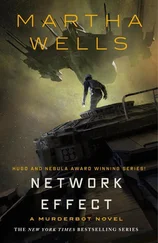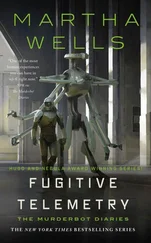Марта Уэллс - Artificial Condition
Здесь есть возможность читать онлайн «Марта Уэллс - Artificial Condition» весь текст электронной книги совершенно бесплатно (целиком полную версию без сокращений). В некоторых случаях можно слушать аудио, скачать через торрент в формате fb2 и присутствует краткое содержание. Город: New York, Год выпуска: 2018, ISBN: 2018, Издательство: Tom Doherty Associates, Жанр: Фантастика и фэнтези, story, на английском языке. Описание произведения, (предисловие) а так же отзывы посетителей доступны на портале библиотеки ЛибКат.
- Название:Artificial Condition
- Автор:
- Издательство:Tom Doherty Associates
- Жанр:
- Год:2018
- Город:New York
- ISBN:978-1-250-18692-8
- Рейтинг книги:5 / 5. Голосов: 1
-
Избранное:Добавить в избранное
- Отзывы:
-
Ваша оценка:
- 100
- 1
- 2
- 3
- 4
- 5
Artificial Condition: краткое содержание, описание и аннотация
Предлагаем к чтению аннотацию, описание, краткое содержание или предисловие (зависит от того, что написал сам автор книги «Artificial Condition»). Если вы не нашли необходимую информацию о книге — напишите в комментариях, мы постараемся отыскать её.
Artificial Condition — читать онлайн бесплатно полную книгу (весь текст) целиком
Ниже представлен текст книги, разбитый по страницам. Система сохранения места последней прочитанной страницы, позволяет с удобством читать онлайн бесплатно книгу «Artificial Condition», без необходимости каждый раз заново искать на чём Вы остановились. Поставьте закладку, и сможете в любой момент перейти на страницу, на которой закончили чтение.
Интервал:
Закладка:
I didn’t, either, but I wasn’t going to tell it that.
I took two cycles to think it over. I didn’t talk to ART about it, or anything else, though we kept watching media together, and it exercised a self-restraint I didn’t think it had and didn’t try to start arguments with me.
I knew I had been lucky up to this point. Onboard the transport I had used to leave Port FreeCommerce, I had compared myself to recordings of humans, trying to isolate what factors might cause me to be identified as a SecUnit. The most correctable behavior was restless movement. Humans and augmented humans shift their weight when they stand, they react to sudden sounds and bright lights, they scratch themselves, they adjust their hair, they look in their pockets or bags to check for things that they already know are in there.
SecUnits don’t move. Our default is to stand and stare at the things we’re guarding. Partly this is because our non-organic parts don’t need movement the way organic parts do. But mostly it’s because we don’t want to draw attention to ourselves. Any unusual movement might cause a human to think there’s something wrong with you, which will draw more scrutiny. If you’ve gotten stuck with one of the bad contracts, it might cause the humans to order the HubSystem to use your governor module to immobilize you.
After analyzing human movement, I wrote some code for myself, to cause me to make a random series of movements periodically if I was standing still. To change my respiration to react to changes in the air quality. To vary my walking speed, to make sure I reacted to stimuli physically instead of just scanning and noting it. This code had gotten me through the second transit ring. But would I be all right on a ring or installation frequented by humans who often saw or worked with SecUnits?
I tweaked my code a little and asked ART to record me again as I moved around its corridors and compartments. I tried to make myself look as much like a human as possible. I’m used to feeling mentally awkward around humans, and I took that sensation and tried to express it in my physical movements. I felt pretty good about the result. Until I looked at the recordings and compared them to ART’s recordings of its crew and my recordings of other SecUnits.
The only one I was fooling here was myself.
The change in movement made me look more human but my proportions exactly matched the other SecUnits. I was good enough to fool humans who weren’t looking for me, since humans tend to ignore non-standard behavior in transitional public spaces. But anyone who had set out to find me, who was alert to the possibility of a rogue SecUnit, might not be fooled, and a simple scan calibrated to search for SecUnit size, height, and weight was certain to find me.
It was the logical choice, it was the obvious choice, and I would still rather peel my human skin off than do it.
I was going to have to do it.
After a lot of argument, we agreed the easiest change for the best result was to take two centimeters of length out of my legs and arms. It doesn’t sound like a big change, but it meant my physical proportions would no longer match Unit standard. It would change the way I walked, the way I moved. It made sense and I was fine with it.
Then ART said we also needed to change the code controlling my organic parts, so they could grow hair.
My first reaction to that was no fucking way. I had hair on my head, and eyebrows; that was a part of SecUnit configuration that was shared with sexbots, though the code controlling it kept SecUnit head hair short to keep it from interfering with the armor. The whole idea of constructs is that we look human, so we don’t make the clients uncomfortable with our appearance. (I could have told the company that the fact that SecUnits are terrifying killing machines does, in fact, make humans nervous regardless of what we look like, but nobody listens to me.) But the rest of my skin was hairless.
I told ART that I preferred it that way and extra hair would just draw unwanted attention. It replied that it meant the fine, sparse hair humans had on parts of their skin. ART had done some analysis and come up with a list of biological features that humans might notice subliminally. Hair was the only one we could change my underlying code to create, and ART proposed that it would make the joins between the organic and inorganic parts on my arms, legs, chest, and back look more like augments, the inorganic parts that humans had implanted for medical or other reasons. I pointed out that many humans or augmented humans had the hair on their bodies removed, for hygienic or cosmetic reasons and because who the hell wants it there anyway. ART countered that humans didn’t have to worry about being identified as SecUnits, so they could do whatever they wanted to their bodies.
I still wanted to argue, because I didn’t want to agree with anything ART said right now. But it seemed minor in comparison to removing two centimeters of synthetic bone and metal from my legs and arms, and changing the code for how my organic parts would grow around them.
ART had an alternate, more drastic plan that included giving me sex-related parts, and I told it that was absolutely not an option. I didn’t have any parts related to sex and I liked it that way. I had seen humans have sex on the entertainment feed and on my contracts, when I had been required to record everything the clients said and did. No, thank you, no. No.
But I did ask it to make an alteration to the dataport in the back of my neck. It was a vulnerable point, and I didn’t want to miss the opportunity to take care of it.
Once we agreed on the process, I stood in front of the surgical suite. The MedSystem had just sterilized and prepped itself and there was a heavy scent of antibacterials in the air, reminding me of every time I had carried an injured client into a room like this. I was thinking about all the ways this could go wrong, and the terrible things ART could do to me if it wanted.
ART said, What is causing the delay? Is there a preliminary process left to complete?
I had no reason to trust it. Except the way it kept wanting to watch media about humans in ships, and got upset when the violence was too realistic.
I sighed, stripped off my clothes, and laid down on the surgical platform.
Chapter Four
I CAME BACK ONLINEto find I was at 26 percent capacity, but the percentage was climbing slowly. Bands of pain circled my knee and elbow joints, so intense I couldn’t process it. My human skin itched. And I was leaking. I hate that.
I didn’t have the capacity to access or play any of my media. All I could do was lie there waiting for my levels to adjust. Attempts to move just made it worse. I wished I had gone with Plan Sixteen to render the ART inoperable, the one with the best statistical chance of success without me taking catastrophic damage in retaliation. Plan Two to blow it up was looking pretty attractive at the moment, too. This had been a stupid thing to agree to.
It was like being in a cubicle after being shot to pieces, but without a cubicle’s ability to shut down higher functions until the repairs were complete. I had known going in that the MedSystem wouldn’t be able to adjust my pain level, but I hadn’t thought it would be this bad. I couldn’t adjust my own temperature, either, but I wasn’t cold, as the MedSystem was controlling the temperature of the room and the platform to keep me at a comfortable level. Cubicles didn’t do that and I had to admit it was nice.
Gradually my levels started to even out and I got back enough function to dial down my pain sensor and turn off the itching. I needed some pain to tell me what not to move until all the regrowth of my organic tissue was complete.
Читать дальшеИнтервал:
Закладка:
Похожие книги на «Artificial Condition»
Представляем Вашему вниманию похожие книги на «Artificial Condition» списком для выбора. Мы отобрали схожую по названию и смыслу литературу в надежде предоставить читателям больше вариантов отыскать новые, интересные, ещё непрочитанные произведения.
Обсуждение, отзывы о книге «Artificial Condition» и просто собственные мнения читателей. Оставьте ваши комментарии, напишите, что Вы думаете о произведении, его смысле или главных героях. Укажите что конкретно понравилось, а что нет, и почему Вы так считаете.












